Sadly, Pig Beach Isn’t Paradise for the Swimming Pigs in the Bahamas


An uninhabited island in the Bahamas, crystal clear waters with tropical fish swimming by, and an endless supply of treats from locals and visitors. And swimming pigs. Pig Beach in the Caribbean sounds like any pig’s dreamland, right?
That’s what I thought when I stumbled upon photos of the swimming pigs on “Pig Island” and booked my honeymoon trip after my vegan wedding to swim with pigs in the Bahamas. As a vegan traveller and a long-time lover of pigs, I thought that nothing in the world could top seeing pigs run free on their own island experiencing total liberation. I couldn’t wait.
But when my husband and I anchored our boat at pig beach, my excitement quickly faded as I had a sinking feeling that something wasn’t right.
Really, a lot wasn’t right.
Reality Hit—Pig Beach Was Not A Happy Place
As I stepped off our little motor boat I was immediately greeted by a stampede of hungry adult pig snouts desperate for food. I threw my open palms in the air signaling to them that I didn’t have any food on me, and they recognized that and quickly lost interest.
It was then that the babies came running over. “My goodness,” I thought. There were tons of them! 10, maybe 15 piglets. Clearly multiple litters.
I kneeled down to greet them. They were so tiny—and dirty! They explored my hands, my shoes, my camera—everything—with their little snouts covered in sand.
After recovering from the glee of fraternizing with little piglets in paradise, I started to notice the abrasions on their skin. I looked closer and saw that the skin on their snouts was peeling, and they had little scabs and marks on their tiny heads.
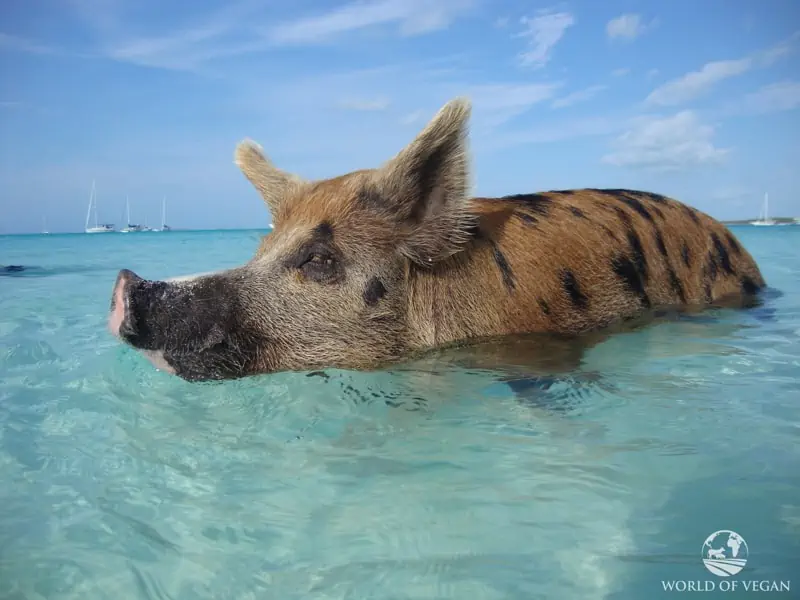
The Swimming Pigs Experience Skin Abrasions, Severe Sunburns & Unreliable Food Sources
I thought back to my visits to Farm Sanctuary, and recalled how the staff there would put sunblock on the pigs during the summer because their pale skin is sensitive and can easily burn. Then I started to worry that all of these pigs were suffering from severe burns from being exposed to the strong Caribbean sunshine day after day.
I spoke with Susie Coston, Farm Sanctuary’s National Shelter Director and the best pig expert I know, and asked her about how the prolonged sun exposure might be affecting the pigs. She said:
“Like anyone, too much sun is not good. Pigs can get skin cancer and other illnesses and likely suffer for a long time without treatment.”
She also reminded me that in nature, pigs coat themselves in mud as natural sun protectant, but on the sandy beach in the Caribbean, they don’t have access to mud. For the pigs on the beach in the Exumas, there was little-to-no sun protection for their fair skin.
So Many Piglets on the Tiny Pig Beach…What Would Happen To Them All?
But it gets worse. Before I even arrived, I wondered what would happen when the pigs started overpopulating the infamous “Pig island,” since there are no predators around and the only limiting resource, I imagined, was food.
It didn’t take long to find the answer to that. This clearly wasn’t a big, lush island that pigs inhabited. From what I saw during my week in the Exumas, all of the pigs were out in the open on the little sandy beach, because that’s where their food source was.
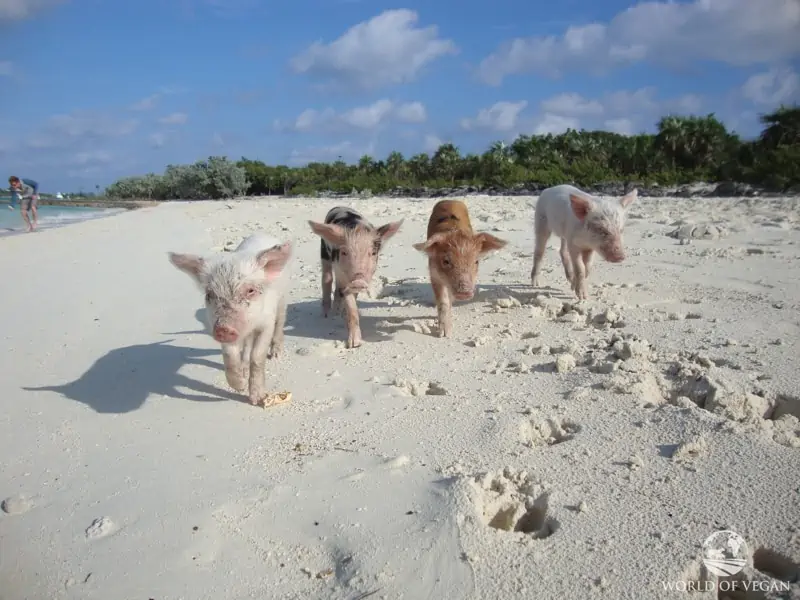
They Would Quickly Overpopulate Pig Island If Left Unchecked
I counted them. There were maybe 20 or 25 pigs total, and most were babies, adolescents, or young mothers. “Where are all the other pigs?” I asked one tour guide who was boasting about how she named all the piglets, and comes every day to feed them pancakes or veggies.
She mumbled something like, “oh, they must be in back.” In back of what? The rocky island, away from their food source? When I pressed further, she quickly changed the subject and no longer had any interest talking with me.
Skeptical and increasingly concerned for the welfare of the world renowned and beloved swimming pigs in the Bahamas, I dug further.
I Learned That Pigs on Pig Beach Are Slaughtered
Finally, I got a more upfront answer from one of the locals who grew up on a neighboring island. With confidence, she said:
“Oh, they have to kill the pigs or there would be too many—especially when they get aggressive. They can be a danger to the tourists, so they have to go.”
She swiped the edge of her hand against her throat as if her words weren’t clear enough.
I pressed on, asking, “Wait, so the pigs on Pig Beach are killed?”
She replied:
“Yeah—but don’t worry, they roast them on a skewer and eat them, and nothing goes to waste. And no, we don’t serve them at the restaurant here—a lot of people ask that!”
She giggled.
My heart sank.
The entire reason I chose this honeymoon destination to swim with the pigs was because I wanted to see pigs who had never been exploited and who got to live out their entire lives in total freedom.
Boy, was I naive.
This Tourist Attraction Is No Paradise For The Pigs
The photos and videos I had seen online made it seem like pig paradise—no part of me imagined that Pig Island was a “managed” tourist attraction where the pigs were culled.
But suddenly everything made sense.
How else would the number of pigs on this little beach remain in check over the course of decades?
I realized that this is an animal tourist attraction not a whole lot different from the orcas imprisoned at SeaWorld or the orangutans at a zoo. The pigs are collectively managed by the locals, and used for profit.
Local guides, Caribbean boat tour companies, and nearby resorts are all profiting from travelers who would give anything—and pay anything—to swim and snap a selfie with the Bahamian pigs.

Tourist Safety Is Certainly An Issue
If this doesn’t bother you, consider the safety of the tourists. While I was in the Bahamas for just one week, I heard several first-hand stories from tourists who were bitten by the pigs. One young man was bitten in the butt when he turned away from the pigs while holding food. Even I was bitten when one of the pigs lunged to grab something out of my hand and accidentally caught my finger at the same time in her powerful jaws.
I asked Susie from Farm Sanctuary about this, wondering what safety concerns people should be aware of when interacting with these hungry, feral-domestic hybrid pigs. She said:
“Pig bites can be pretty serious. Pigs have strong jaws and can have a very crushing, bone breaking bite. They also often break skin. They can do serious damage.”
Pig Bites Can Cause Serious Damage
Despite this, most of the tourists I talked with were not aware of any safety precautions they should take when interacting with the pigs. And the things I saw tourists do for the sake of a selfie photo were cringeworthy. It’s amazing there are not already more serious stories circling about serious injuries at Pig Island… but it’s only a matter of time.
So even if you’re not concerned about the wellbeing of the pigs on this island, consider the tourists who come every year to snap a photo with the famous swimming pigs, completely unaware of how to interact with pigs and the risk involved.
What’s Wrong With Pig Island (Big Major Cay)?
To sum it up, here are the problems I learned about during my time at Pig Beach:
The pigs are killed.
Pigs can have upwards of twenty piglets each year, and they can start having babies when they’re just a year and a half old. Without killing the pigs (or giving the piglets away to locals for food), there would be no way to maintain the small population of pigs on the various islands.
The pigs can suffer from severe sunburn and skin cancer.
Spending their days in the blazing sun without protection from mud or other forms of sunblock (especially those with fair skin) commonly causes skin cancer in pigs. Without an enticement to stay in the shade, these swimming pigs are extra susceptible.
The pigs’ food source is unreliable.
Their primary food source comes from locals and visiting tourists. When pigs are food-aggressive and there is a lot of food competition among the pigs, that is a sign that they are probably hungry and not getting enough to eat. The pigs also have heightened stress and become more aggressive when they are deficient in nutrients.
The pigs don’t have adequate shelter.
They are exposed to the sun, rain, and especially the harsh Caribbean storms and hurricanes.
The pigs are an unusual feral-domestic hybrid.
As enormous non-native animals that are an unusual mix between feral and domestic, they run right up to people, but are often aggressive and pose a serious danger to visitors. But there is nobody looking out for the safety of tourists (unless they are there with a tour company).
The swimming pigs are a major tourist attraction.
Many individuals and companies profit (big time) off of them. As we see time and again, profiting off of the lives of others often leads to exploitation.
More “pig islands” are sprouting up.
As business savvy locals see how effective they are at attracting tourists and generating profit. Some entrepreneurial locals are bringing pigs to create new “pig islands.” This is a huge problem, especially considering there is no oversight or accountability for the wellbeing of the pigs.
Bottom line—the pigs are not living out long lives of freedom on a deserted island in the Bahamas.
Sure, it’s better than a factory farm, but Pig Island is no paradise for pigs.
Note: There are now several islands in the Bahamas where individuals and tour companies have brought pigs to create additional swimming pig attractions. They all have different degrees of care and oversight.
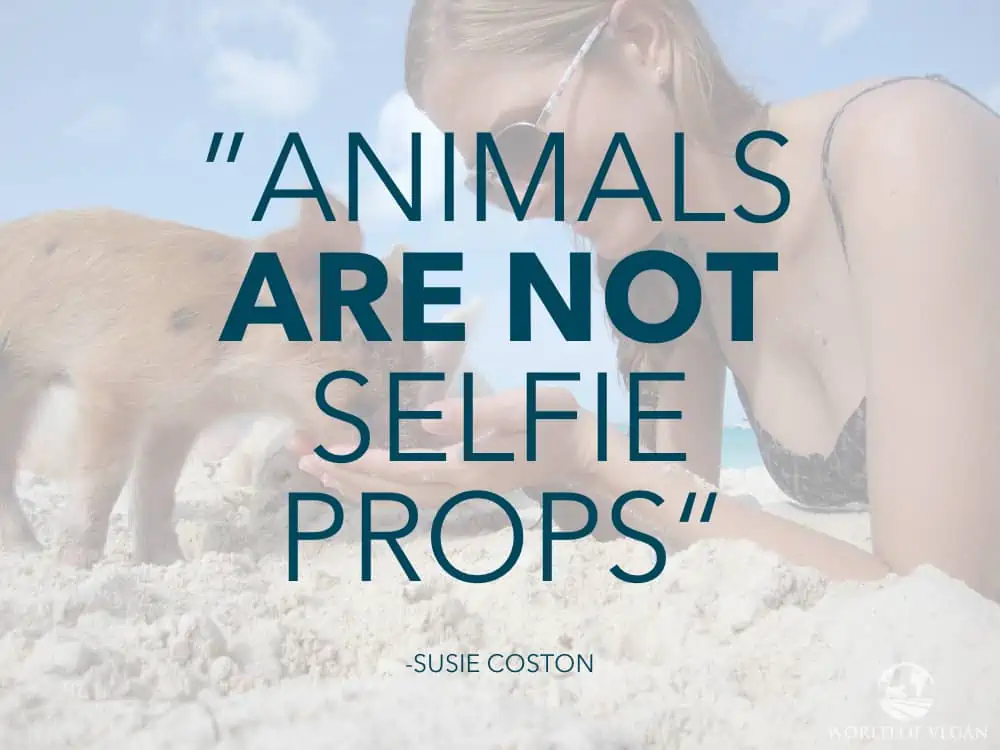
Is the Island With Swimming Pigs All Bad?
At this point, you might be thinking, “What’s she so worked up about? At least these swimming pigs aren’t locked up on a factory farm!” And that’s a fair point.
Life for most pigs in today’s world is excruciating. Most pigs in existence today are suffering factory farms living a horrendously torturous and sad life. But is that an excuse to lower our standards of care and compassion for the species? Absolutely not.
Of course, it is worth noting that Pig Island has brought incredible positive press for pigs, showing that they are smart, curious, playful, lovable animals not unlike the dogs and cats we adore at home. Presumably, these pigs have inspired countless people to leave pork and bacon of their plate—which is wonderful.
Choose A Kinder Adventure In The Bahamas
But we don’t need to continue to spread a false story of happiness at the expense of these pigs—especially when there are pigs like Esther the Wonder Pig who is a real-life example of a truly happy, healthy, beloved pig.
There are plenty of other reasons to visit the Bahamas—the beaches are beautiful, and you can enjoy activities like snorkeling, paddle boarding, island hopping, and even swimming near wild sharks. The locals are incredibly friendly and kind, and it really is a beautiful place.
One Bahamian wrote in sharing the following:
The Bahamas recently outlawed the fishing of sea turtles and was declared a shark sanctuary, protecting sharks from commercial fishing. In 1958 The Exuma Cays Land and Sea Park was the first national park of its kind to have both a land and sea component. The 176 square mile park is a ‘no-take’ park where nothing within its boundaries can be removed.
Other beautiful, endangered animals like the Flamingo, the Bahama parrot and Rock iguanas are also fully protected and areas of their natural habitat have been set aside and declared as sanctuaries for them. These sanctuaries are The Bahamas National Parks. The parks are speckled throughout the islands and are open to the public so people may witness these animals in their natural habitat.
You might have been in search of a pig sanctuary, but the whole time you were sailing past a world of sanctuaries waiting for you to discover them.
What Can You Do to Help the Swimming Pigs?
Despite all these problems, Pig Beach has seen a recent surge in popularity, with tourists visiting from all around the world. While I was there, there was a group who had traveled all the way from Japan to the Bahamas for just one day, just to see the pigs. That’s where you come in.
Please help spread the word to let people know that Pig Island is no paradise for the pigs, but rather a tourist attraction not a whole lot different from Sea World or the Zoo. Instead of googling “Where can you swim with pigs?” and booking a flight, plan a trip to an animal sanctuary like Farm Sanctuary or Animal Place! There are hundreds of sanctuaries all around the world where you can visit pigs, rub their bellies, and support liberation rather than exploitation.

Urge the Government to Take Action
We can also put pressure on the government, tour companies, and local resorts to do better. There is currently no oversight or transparency. We really need to act now to stop this problem from growing (and spreading to more islands), and also urge the government and tour companies to at the very least neuter the male pigs, provide sturdy shelter to protect them from the storms, and assign someone to look out for their care and wellbeing (food, water, sun protection, veterinary care, etc).
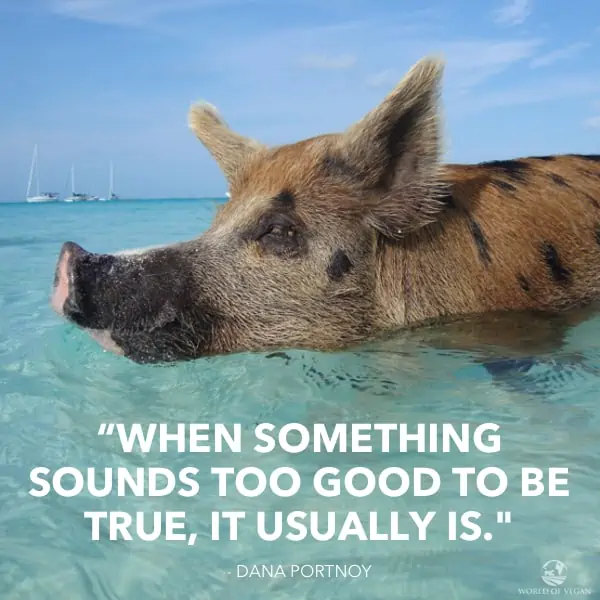
Choose Cruelty-Free Travel & Compassionate Vacations
There are so many wonderful places to travel and summer vacation activities to participate in without exploiting animals. Instead of visiting pig island, how about one of these vegan-friendly travel destinations? Consider a trip to NYC, San Francisco, Sacramento, Seattle, London, Chile, or Paris, which all have vibrant vegan scenes! Or you could book a getaway to an all vegan resort like The Stanford Inn By The Sea in Northern California or one of the other many vegan hotels and resorts around the world!
Vegan-Friendly Travel Destinations
Here are some city guides for popular vegan travel destinations:
- Kauaii, Hawaii Vegan Guide (for the tropical vacation lover—go snorkeling with sea life that’s meant to be in the ocean)
- New York City Vegan Guide
- Austin, Texas Vegan Restaurant Guide
- San Francisco Vegan Guide
- Best Vegan Restaurants in Oakland, California
- Best Vegan Restaurants in Berkeley, CA
The sky is the limit—and I promise that when you’re visiting a place that you know is not doing harm you’ll have a much better time.
This article about the swimming pigs in the Exumas was written and photographed by yours truly, Michelle Cehn. This article is based on my personal first-hand experience on my trip to the Bahamas for my vegan honeymoon.



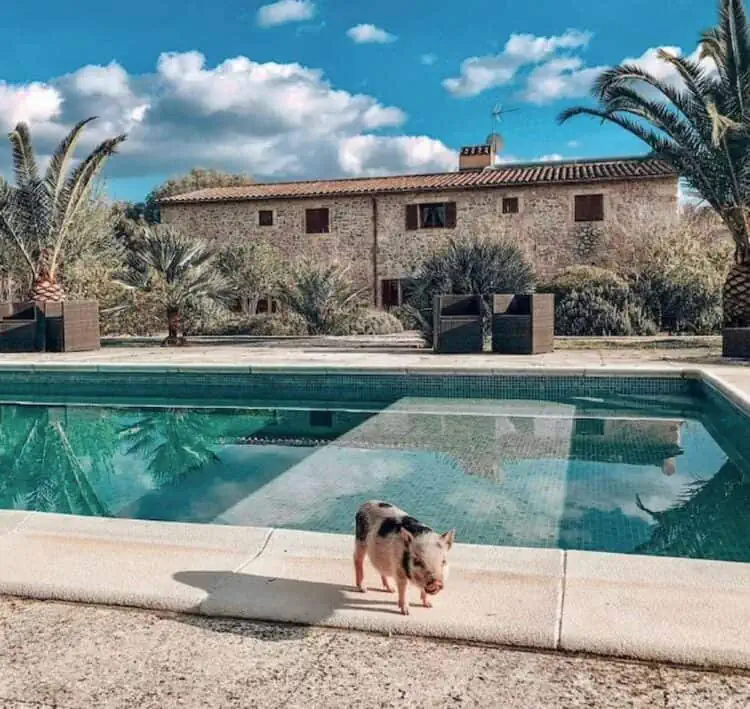


Leave a Comment
I was devastated to hear this. It was a dream of mine to go but now I just wonder what help there could be for the pigs. Also if they are killing them because they get overpopulated why not have them spayed and neutered then that part of the problem would be solved. I guess that is unthinkable to them.
We are equally devastated. It’s heartbreaking to learn about the reality of the pigs. Implementing a spaying and neutering program could indeed help manage the population — hopefully, that is something they consider instead. We are glad this article continues to raise awareness and appreciate you sharing your thoughts, Yolonda!
Feral hogs ruin the local environment and ecosystem, and can reproduce every 6 months. Honestly, they just need to be eradicated and pig island needs to go away. I know it’s not a vegan or peta approach, but it’s the only way it’ll actually stop.
I had no idea of the reality of these poor pigs on pig island. It was my dream to visit there. After reading the reality of pig island. I will definately not be visiting
Poor pigs . Bless them.
It is indeed disheartening to learn about the reality of pig island. Thank you for making the compassionate choice to not support it!
Thank you for writing about the pigs. This is heart breaking. We are planning a trip to the Bahamas and will not participate in the touring of the pigs. This is just awful.
Thank you for taking the time to read this. It is indeed heart-breaking so thank you for making a kind choice by not supporting it! We hope you have a wonderful time on your trip!
Without providing an alternative that still draws tourists and affords the locals work and income, the human standard will be worse off.
I heard about it from my cousin’s pictures and thought wow this place is wonderful I wish I could go there but I am paralyzed and then I found your site I couldn’t believe my eyes I think this is wonderful information and more people need to know about it. I wish you would make a story on Instagram. I follow that or maybe TikTok I know the younger generation follows that. There is a place in New York parksville to be exact that a pig sanctuary is there the place is wonderful it’s run by a man named Todd I’m sorry I can’t think of the name of it I think it’s Arthur something you should check it out. I hear the pigs don’t have water on pig island because of the storms wiped out their supply and it’s in bad shape right now anyway thanks for the story Viva La Oink! LoL ✌️❤️&
Thanks, Mary! That is a great idea to share this on social media. It’s so sad to hear the pigs aren’t doing well right now. We do have a farm animal sanctuary guide, if you happen to remember the name of the pig sanctuary, we’d be happy to add them to the list 🙂
When I viewed my first swim with Pig’s video on youtube I could see that something was off. The pigs were not swimming they were going into the salt water to get food from Tourist. I could see that the pigs were not happy. The question came to mind, was there a natural fresh water source? How were the pigs getting fresh water . They can not drink sea water. The pigs were unhappy and appeared stressed for food. I have been to the Bahamas and I should not have expected anything more than a sad existance for the pigs. The Bahamian people I ran into many were hotel workers tour guides boat captains were for the most part dim. The attitude was the only good animal was the one roasting in my fire pit. Sad but that is how it is in most of the Islands I have been to many of them.
Hi, thank you for spreading this awareness. I love pigs and had no idea these islands with pigs were a thing. The first thing that comes to my mind while reading that you want people to stop visiting these piggies, is how will they eat if visitors stopped going to feed them? You said that seems to be their
main source of food. Hopefully as long as the pigs remain on the islands people will still visit to feed them. Otherwise an organized rescue needs to be formed and action to either build proper shelters and facilities for these pigs. Provide education to caretakers or even provide proper care. Create sun protection and reliable food sources or else remove these pigs from the island. Then, the tourists will stop visiting. Until then those pigs could starve to death on that island and become aggressive toward each other to survive. It would quickly turn into hell island. Until you are able to take the necessary steps to actually do something real about the situation. Until then the visitors are a blessing for those pigs and provide food for them. Keep those pigs fed any way possible until you can take action. It’s quite an undertaking and I wish you the best! We are all rooting for you!
Thank you for this information I will not be visiting or endorsing this kind of thing unfortunately there’s a lot about animals that are inhuman we all need to know more about. Thanks for shedding some light
My dream was to meet pig in ocean. Every night I sleep with sweet dream of free range simmy piggy, and every day I work to save money. I went vegan 4 weeks ago, and have never looked back. Thank you for shattering my dreams. I would rather be heart broken than watch pig get sun burn
I’m so so sorry. If your heart is set on going, you could always document the conditions, ask the tough questions of the locals, and spread awareness about the reality of the situation. But I feel you, my heart was shattered too, because I so believed that it was a true paradise for pigs 🙁 On another note, that’s rad that you went vegan a month ago! Hope you’re loving it so far <3 We have lots of guides I hope can be helpful! - Michelle 🙂
Hi,
Reading this article I don’t believe that you actually went to pig beach. First off pig beach is also home to a few different breeds of sharks so the pigs are not just roaming the beach they are taken care by someone that lives on the island they are fed regularly. The tour usually starts out with a sting Ray feeding then shark show then the pigs are let out of a pen last and when they do come out they are covered in mud your article seems very far from the tour that I recently took with my friends.
Hi! I definitely went, there are photos of me with the pigs here 🙂 There are now many different pig beaches, the idea has spread fast that it’s a great tourist attraction, so perhaps you went to a different island. But most of the islands with pigs are not habitable; they are so small and rocky and dense there are no houses or humans living on them. If the pigs are in a pen that’s a very different place; most people are looking for the pig island which is made to look like the pigs natively and freely live there. Wishing you well!
Great article
But this is tourism and money talks and pigs will be ate for meat every day.
Anyone that thinks a bunch of hybrid pigs are living out their lives on a deserted island and not being taking for food is insane. Or maybe that’s what some people think. Well time to see the bigger picture. Pigs equal money from tourism and food in locals tummies.
Thank for this article! And perhaps the original pig island was not created for them to be exploited, but unfortunately these are the ways of the world. Reading through your comments I noticed so many bringing up human rights and child suffering , although these topics are extremely serious and important, THIS TOPIC is ABOUT PIGS! You can write about whatever interests you choose without taking away from the importance of any other world issue..
Interesting how humans can make a long post about pigs and other animals sufferings but ignore the suffering of children, elderly, homeless, sick, abused, poor etc. I’m all for voicing but it should start with love for your fellow mankind first.
Hey Wendy 🙂 I’d love to hear about some of the things you’re doing for humans and children to inspire us all to do the same! Wonderfully, there is no limit to compassion, kindness, and our ability to stand up for those who can’t speak for themselves. You will likely find that those who are advocating for mistreated animals are also some of the biggest advocates for human rights. Much love to you!
Would like to insert ‘exploitation on third-world countries by developed nations.’ to my first and only comment because there doesn’t seem to be a way to edit comments.
I would like to see your write up on the deliberate exploitation of humans by the big players involved in this pandemic or even the deliberate exploitation by developed countries of the natives of the third world countries like Haiti or some parts of Africa. While I understand your concern for the well being of the pigs and the need for some intervention the program did not originally start out as one of exploitation. The locals of the outer islands often use uninhabited neighboring island to raise animals and what started out as just that became a tourist attraction only after a few years of passing visitors and locals telling stories of pigs swimming up to meet them as they passed near the island, hence the dream of a tourist attraction was born. Our country’s natural resources are being exploited by foreigners mostly due to lack of knowledge from our leaders and so the locals have to take advantage of every opportunity they get but unfortunately others have moved in to help themselves to the spoils.
Your concerns were well received up to the point where you gave suggestions that would ultimately divert tourist dollars elsewhere on the pretense that the idea of the attraction was based on exploitation. Please send me any and all writings on the aforementioned, thanks you.
I am currently a care taker for not only the pigs at Sandy Toes, Rose Island, but the animals in general. We have nine pigs in which six of them were purchased from the slaughter to save their lives, whilst the the three stooges were purchased for learning purposes as they were much smaller henceforth easier to manage. We use a training process called operant conditioning and positive reinforcement simply do something good, get something good in return. I understand your concerns with the others but I can assure you that at Sandy Toes Rose Island, we care for our animals as they will never be slaughtered simply because that defeats the purpose of why they were purchased. Granted, interactions wasn’t the original plan however, because it the environment in which they reside, guests wanted to meet them. As far as how they are living, please come and see for yourself. I promise you will reconsider this comment.